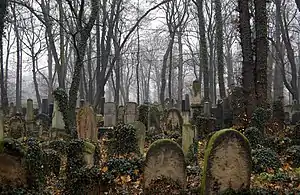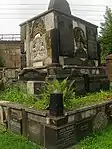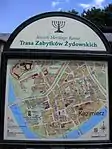New Jewish Cemetery, Kraków
The New Jewish Cemetery (Polish: Nowy cmentarz żydowski w Krakowie) is a historic necropolis situated on 55 Miodowa Street in Kraków, Poland. Located in the former Jewish neighborhood of Kazimierz, it covers an area of about 4.5 hectares (11 acres).[2] Since 1999, the cemetery is a registered heritage monument. The grounds also feature a well-preserved mortuary.[3]
| New Jewish Cemetery Nowy cmentarz żydowski | |
|---|---|
 General view | |
| Details | |
| Established | 1800 |
| Location | 55 Miodowa Street, Kraków |
| Country | Poland |
| Coordinates | 50°03′12″N 19°57′07″E |
| Type | Jewish cemetery |
| Owned by | Jewish Religious Community in Kraków |
| Size | 4,5 ha[1] |
| No. of graves | Approximately 10,000 |
| Find a Grave | New Jewish Cemetery Nowy cmentarz żydowski |
11.jpg.webp)
History
The New Jewish Cemetery was founded in 1800 on grounds purchased by the Jewish Qahal from the Augustinians. It was enlarged in 1836 with additional land purchased from the monks. Following Poland's return to independence, the New Cemetery became nearly full.[4] From 1932 on, burials were directed to a new plot bought in 1926 by the Qahal along Abrahama Street and the one at nearby Jerozolimska Street, both in the Wola Duchacka neighborhood (now part of Podgórze district). These two other cemeteries formed the site of the Kraków-Płaszów concentration camp during the Holocaust and no longer exist.[5] The Jews from the Kraków Ghetto were sent there.[2][6]
World War II
Following the Nazi invasion of Poland in World War II, the New Cemetery was closed to outsiders and the Germans sold the most valuable stonework to local masons. Other headstones, as well as slabs, were turned into construction material and used for paving the supply road to the camp, including the courtyard of commandant Amon Göth,[2] who is known for having insisted that the Jews pay for their own executions.[7] Meanwhile, the old bones at the cemetery were often left uncovered and scattered around in what looked like an open-pit mine.[2][4] Caretaker Pina Ladner, who used to live on premises, was sent to Płaszów beforehand, and shot.[8]
Soon after the war ended, a local civil engineer identified only as Mr. Stendig,[5][8] likely Jakub Stendig, a camp survivor,[note 1] recovered many tombstones from the Płaszów camp site, and arranged to have them reinstalled at the New Cemetery.
Restoration
In 1957, the grounds were renovated with funds from the Joint Distribution Committee. On March 24, 1999, the cemetery, including the 1903 mortuary, were entered into the register of historical monuments of Kraków.[3]
The New Jewish Cemetery features a renovated brick mortuary hall built in 1903, as well as the postwar lapidary memorial fitted with old headstones and crowned with a block of black marble. The cemetery contains over 10,000 tombs, the oldest dating from 1809.[5] There are many monuments commemorating the death of Jews killed during the Holocaust.
Notable individuals buried at the cemetery
Those buried at the New Jewish Cemetery of Kraków include:
|
|
Picture gallery
 Street view
Street view In winter
In winter38.jpg.webp) Tombstone memorial
Tombstone memorial Tombstone memorial
Tombstone memorial Panoramic view
Panoramic view The funeral gate
The funeral gate15.jpg.webp) Alleyway between tombs
Alleyway between tombs Symbolic graves
Symbolic graves View in summer
View in summer City map of Jewish heritage
City map of Jewish heritage
See also
- Remuh Cemetery known also as the Old Jewish Cemetery of Kraków
- Rakowicki Cemetery, the main necropolis of the city of Kraków
Footnotes
- Jakub Stendig was a civil engineer who worked in Płaszów camp as a prisoner architect. He was the son of Anschel Stendig, a wealthy citizen. Prior to the invasion, Stendig had graduated from the Technical Academy in Lwów and the Academy of Fine Arts in Kraków. He survived both Płaszów and Gross-Rosen concentration camps.[9]
References
- "Nowy cmentarz żydowski" (in Polish). Opowiedz mi miasto website, project of the Historical Museum of Kraków. Retrieved October 10, 2022.
- "The New Jewish Cemetery," at Jews and Krakow. p. 12. Archived 2012-04-25 at the Wayback Machine (PDF) Featuring historical and contemporary photographs, as well as bibliography. Format: PDF 5.51 MB. Retrieved October 29, 2011.
- Narodowy Instytut Dziedzictwa: Rejestr zabytków nieruchomych – województwo małopolskie. ("749 KB".
{{cite web}}: Missing or empty|url=(help)749 KB ) 2010-06-30. p. 47. (in Polish) - K. Bielawski, Nowy cmentarz żydowski w Krakowie. Source: Aleksander Bieberstein, Zagłada Żydów w Krakowie. Kirkuty.xt.pl. Retrieved October 29, 2011.
- "Cmentarz zydowski w Krakowie/Jewish cemetery in Cracow". October 13, 2007. Archived from the original on 2007-10-13.
- Nowy cmentarz at Magiczny Kraków. Official website of the city.
- "The SS: A Government in Waiting". Yizkor Book Project. JewishGen. 2011. Retrieved April 26, 2011.
- Kraków – Cemetery at ul. Miodowej 58. (New Jewish Cemetery) Archived 2012-04-02 at the Wayback Machine Virtual Shtetl Museum of the History of Polish Jews. Retrieved November 1, 2011. Note, the custodian who recovered tombstones from Płaszów, mentioned by his last name only, as Engineer Stendig.
- Gustawa (Gutka) Stendig-Lindberg and her family. Kraków – Virtual Shtetl.
External links
 Media related to New Jewish Cemetery in Kraków at Wikimedia Commons
Media related to New Jewish Cemetery in Kraków at Wikimedia Commons- 26332484 Location of the New Jewish Cemetery in Krakow on OpenStreetMap
- New Jewish Cemetery, Kraków at Find a Grave